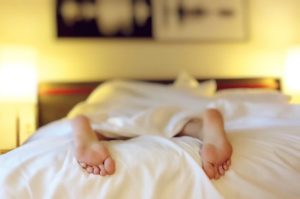Sleeping face down can kill you!
 The following study involves a meta-analysis which linked people who have epilepsy to suddenly and unexplainably dying in their sleep particularly when they sleep face down. Although the risks of suddenly dying during sleep are unknown and likely multifactorial, the prone position might be an important contributory factor.
The following study involves a meta-analysis which linked people who have epilepsy to suddenly and unexplainably dying in their sleep particularly when they sleep face down. Although the risks of suddenly dying during sleep are unknown and likely multifactorial, the prone position might be an important contributory factor.
The Research
Epilepsy Behav. 2017 Sep 13. pii: S1525-5050(17)30231-7. doi: 10.1016/j.yebeh.2017.08.021. [Epub ahead of print]
Association of sleep with sudden unexpected death in epilepsy.
Ali A1, Wu S1, Issa NP1, Rose S1, Towle VL1, Warnke P2, Tao JX3.
1
Department of Neurology, The University of Chicago, Chicago, IL 60637, USA.
2
Department of Neurosurgery, The University of Chicago, Chicago, IL 60637, USA.
3
Department of Neurology, The University of Chicago, Chicago, IL 60637, USA. Electronic address: jtao@neurology.bsd.uchicago.edu.
Abstract
OBJECTIVE:
The objective of this study was to determine the association of sleep with sudden unexpected death in epilepsy (SUDEP).
METHODS:
We conducted a systematic review and meta-analysis based on literature search from databases PubMed, Web of Science, and Scopus using keywords “SUDEP”, or “sudden unexpected death in epilepsy”, or “sudden unexplained death in epilepsy”. Sudden unexpected death in epilepsy was considered to occur during sleep if the patient was found in bed, if the SUDEP cases were documented as in sleep, or if the patient was found at bedside on the bedroom floor.
RESULTS:
Circadian pattern was documented in 880 of the 1025 SUDEP cases in 67 studies meeting the inclusion and exclusion criteria. Of the 880 SUDEP cases, 69.3% occurred during sleep and 30.7% occurred during wakefulness. Sudden unexpected death in epilepsy was significantly associated with sleep as compared to wakefulness (P<0.001). In the subgroup of 272 cases in which circadian pattern and age were documented, patients 40years old or younger were more likely to die in sleep than those older than 40years (OR: 2.0; 95% CI=1.0, 3.8; P=0.05). In the subgroup of 114 cases in which both circadian pattern and body position at the time of death were documented, 87.6% (95% CI=81.1%, 94.2%) of patients who died during sleep were in the prone position, whereas 52.9% (95% CI=24.7%, 81.1%) of patients who died during wakefulness were in the prone position. Patients with nocturnal seizures were 6.3 times more likely to die in a prone position than those with diurnal seizures (OR: 6.3; 95% CI=2.0, 19.5; P=0.002).
CONCLUSIONS:
There is a strong association of SUDEP with sleep, suggesting that sleep is a significant risk factor for SUDEP. Although the risks of SUDEP associated with sleep are unknown and likely multifactorial, the prone position might be an important contributory factor











